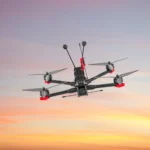Every October, Earth passes through a stream of debris left by Halley’s Comet, producing the stunning Orionid Meteor Shower.
This annual celestial event is one of the brightest and most anticipated night-sky spectacles. In 2025, sky-watchers across the world are preparing for a dazzling show of shooting stars.
The display reaches its peak in mid-October, offering a perfect opportunity to witness nature’s fireworks.
Whether you are a stargazing enthusiast or a casual observer, understanding when, where, and how to watch the shower can make your experience truly memorable. Read our other article on Top Handheld PCs.
When Does the Orionid Meteor Shower Peak?
The Orionid Meteor Shower’s October peak occurs between October 20 and 22, with the best visibility expected on the night of October 21 and early hours of October 22.
According to astronomers, viewers could see up to 20 meteors per hour under ideal dark-sky conditions.
The radiant—the point from which the meteors appear to originate—lies in the constellation Orion, near the bright star Betelgeuse.
The best viewing time is just after midnight until dawn, when Orion rises higher in the southeastern sky.
This year’s waxing crescent Moon sets early, which means minimal light interference and a clear view of the meteor shower tonight for most locations.

Where Is the Best Place to See the Orionids?
If you live in a city, light pollution can limit visibility. To fully enjoy the show, head to a dark area away from urban glow. National parks, rural fields, or mountain tops offer ideal vantage points.
Observers in the Northern Hemisphere—especially in North America, Europe, and Asia—will have prime viewing conditions.
However, those in the Southern Hemisphere can still catch the Orionid meteor showers rising later in the night.
Remember to allow your eyes at least 20 minutes to adjust to darkness. Lie back on a blanket or reclining chair, face the open sky, and let your gaze drift naturally—meteors can appear anywhere, not just near Orion.
The Science Behind the Orionids
The Orionids originate from Halley’s Comet, one of the most famous celestial visitors. As the comet travels around the Sun every 76 years, it leaves a trail of icy and dusty debris.
When Earth crosses this path each October, those particles burn up in our atmosphere, creating bright streaks of light.
Each meteor travels at speeds of about 41 miles per second (66 km/s), making the Orionids some of the fastest meteors of the year.
Their swift movement often produces glowing trails that linger for seconds—sometimes even leaving faint smoke lines visible to the naked eye.
Astronomers also note that some meteors display vivid colors, from white to green or even orange, depending on the minerals burning up during entry.
How to Watch the Orionid Meteor Shower
Best Time for Viewing
For most regions, the best time to watch is between midnight and dawn. At this point, Orion is high above the horizon, and you’ll have the greatest chance of spotting multiple meteors.
If you’re wondering what time the meteor shower is tonight, aim for 1 a.m. to 5 a.m. local time. Early risers may also catch a glimpse before dawn as the radiant continues to climb.
Ideal Conditions for Viewing
Check the weather forecast in advance. Clear skies and low humidity improve visibility. If you can, plan to observe from high altitudes or wide-open plains.
Avoid artificial lights, and use a red flashlight if you need to move around—white light ruins night vision.
For added comfort, bring a chair, blanket, and a warm drink. Patience is key; it can take several minutes between bursts of activity.
Connection to Halley’s Comet
The Orionids’ parent body, Halley’s Comet, last visited the inner solar system in 1986 and will return in 2061. Yet, each year its dust continues to illuminate Earth’s skies.
The same comet also causes another event—the Eta Aquarids in May. Both showers are reminders of Halley’s enduring influence on our planet’s atmosphere.
When watching the Orionid Meteor Shower, you’re essentially seeing fragments of Halley’s Comet vaporize—a cosmic connection spanning centuries of observation and discovery.
Other Celestial Highlights During Orionids
In addition to meteors, stargazers this week can spot comet activity from two other visitors: Comet Lemmon and Comet Swan, both bright enough for binocular viewing.
As these comets pass near Earth, they create glowing tails that sometimes overlap with the path of the Orionid meteor shower comets visible from rural areas.
This combination of shooting stars and comets makes mid-October one of the most exciting times of the year for astronomy enthusiasts.
What Makes the Orionids Special?
While there are many meteor showers throughout the year, the Orionids are known for their speed, brightness, and lasting trails. Their connection to Halley’s Comet gives them unique scientific value.
Additionally, the shower coincides with mild autumn nights in the Northern Hemisphere, making viewing comfortable compared with the chillier winter displays like the Geminids or Quadrantids.
For those asking, is there a meteor shower tonight? The answer is yes—on peak nights, the Orionids will put on an exceptional show visible from most parts of the world.
Viewing Tips for Stargazers
1. Plan Ahead
Use stargazing apps to find Orion’s location before the night begins. Apps like Sky Guide or Star Walk 2 help track the constellation in real time.
2. Avoid City Lights
Even partial light pollution can reduce visibility by 50 %. Head to dark-sky reserves or rural spots to enhance the experience.
3. Dress for Comfort
Nights in October can be chilly. Wear layers, bring gloves, and stay warm. Comfort helps you focus on the spectacle instead of the cold.
4. Capture the Moment
If you’re photographing the Orionid meteor showers, use a DSLR camera on a tripod with a long exposure. Aim your lens slightly away from Orion to capture wider sky coverage.
5. Be Patient
Meteor activity often occurs in bursts. Stay outside for at least an hour to increase your chances of seeing multiple shooting stars tonight.
The Role of Astronomy Organizations
Astronomical societies such as the American Meteor Society (AMS) and NASA regularly update viewing predictions and scientific data.
The AMS offers interactive sky maps, while NASA provides live streams of the Orionid meteor shower for those unable to see it in person.
Their collaborative efforts make cosmic events accessible to millions, fostering greater public interest in astronomy.
Impact on Local Communities
Cities like Pittsburgh, Denver, and Seattle are hosting public stargazing events during the Orionid peak. Local observatories will set up telescopes and provide education sessions for families.
Community events not only promote science literacy but also strengthen social connections. Sharing the experience of a meteor shower creates a sense of wonder that transcends age, culture, and background.
Why You Should Watch the Orionids
Witnessing the Orionid Meteor Shower is more than just entertainment—it’s a humbling reminder of Earth’s place in the universe.
Each streak of light marks a fragment of a comet that has traveled for thousands of years before burning up in our sky.
Such events inspire curiosity, fuel scientific discovery, and remind us how fragile and interconnected our world truly is. Even if you catch only a few meteors, the experience can be unforgettable.
Conclusion
The Orionid Meteor Shower is one of nature’s most breathtaking annual displays, offering a chance to see history, science, and beauty converge in the night sky.
From fragments of Halley’s Comet to glowing trails that light up the heavens, this celestial show is a gift worth witnessing.
To enjoy it fully, plan, find a dark spot, and look up with patience and wonder. Whether you’re a lifelong stargazer or simply seeking peace under the stars, the Orionids promise a night you won’t forget.
Don’t miss this opportunity to connect with the cosmos—your window to eternity might just streak by in a flash of light.
FAQs
What is the Orionid Meteor Shower?
It’s an annual event created by debris from Halley’s Comet burning in Earth’s atmosphere.
When can I see the Orionids?
They peak between October 20–22, with the best visibility after midnight.
Where should I look to see the meteors?
Face the southeastern sky toward the constellation Orion, near Betelgeuse.
How many meteors can I expect per hour?
On a clear, bright night, you might see 15 to 20 meteors per hour.
Can I see the Orionids without equipment?
Yes—no telescope needed. Just find a dark spot, let your eyes adjust, and enjoy.














